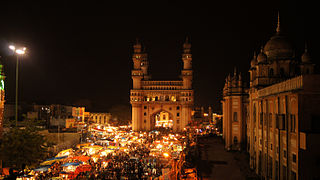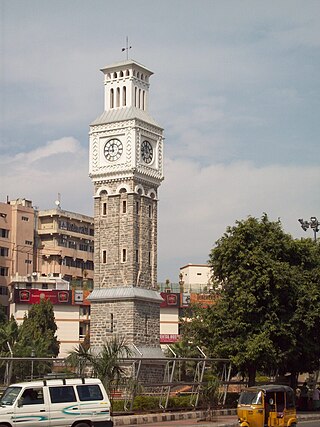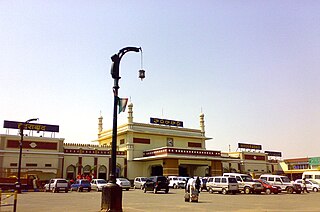
Hyderabad is the capital and largest city of the Indian state of Telangana. It occupies 650 km2 (250 sq mi) on the Deccan Plateau along the banks of the Musi River, in the northern part of Southern India. With an average altitude of 542 m (1,778 ft), much of Hyderabad is situated on hilly terrain around artificial lakes, including the Hussain Sagar lake, predating the city's founding, in the north of the city centre. According to the 2011 census of India, Hyderabad is the fourth-most populous city in India with a population of 6.9 million residents within the city limits, and has a population of 9.7 million residents in the metropolitan region, making it the sixth-most populous metropolitan area in India. With an output of US$ 95 billion, Hyderabad has the sixth-largest urban economy in India.

Hyderabad State or Hyderabad Deccan was a kingdom, country, and princely state in the Deccan with its capital at the city of Hyderabad. It is now divided into the state of Telangana, the Kalyana-Karnataka region of Karnataka, and the Marathwada region of Maharashtra in present-day India, which annexed it in 1948.

Secunderabad is a twin city of Hyderabad and one of the six zones of the Greater Hyderabad Municipal Corporation (GHMC) in the Indian state of Telangana. It is the headquarters of the South Central Railway zone. Named after the Mir Akbar Ali Khan Sikander Jah, Asaf Jah III, Nizam of the Asaf Jahi dynasty, Secunderabad was established in 1806 as a British cantonment. Although both the cities are together referred to as the twin cities, Hyderabad and Secunderabad have different histories and cultures, with Secunderabad having developed directly under British rule until 1948, and Hyderabad as the capital of the Nizams' princely state of Hyderabad. Since 1956, the city has housed the Rashtrapati Nilayam, the winter office of the president of India. It is also the headquarter of the 54th Infantry Division of the Indian Army. There are also many apartments and residential areas, particularly in the small neighbourhood of Yapral.

The Musi River is a major tributary of the Krishna River in the Deccan Plateau, flowing through Telangana, India. The river's historical name is Muchukunda. Hyderabad stands on the banks of the Musi River, which divides the historic Old City from the new city. The Musi River flows into Himayat Sagar and Osman Sagar, which are artificial lakes that act as reservoirs that once supplied the twin cities of Hyderabad and Secunderabad with drinking water. It originates in the Ananthagiri Hills, near Vikarabad. It generally flows towards the east, turning south at Chittaloor. It flows into the Krishna River at Vadapally near Miryalaguda in Nalgonda district.

Osman Sagar is a reservoir in the Indian city of Hyderabad. The lake is around 46 km2, and the reservoir is around 29 km2, with total level of 1,790 feet and a capacity of 3.9 tmc ft.

Mir Osman Ali Khan, Asaf Jah VII was the last Nizam (ruler) of the Princely State of Hyderabad, the largest state in the British Indian Empire. He ascended the throne on 29 August 1911, at the age of 25 and ruled the State of Hyderabad between 1911 and 1948, until India annexed it. He was styled as His Exalted Highness (H.E.H) the Nizam of Hyderabad, and was widely considered one of the world's wealthiest people of all time. With some estimates placing his wealth at 2% of U.S. GDP, his portrait was on the cover of Time magazine in 1937. As a semi-autonomous monarch, he had his mint, printing his currency, the Hyderabadi rupee, and had a private treasury that was said to contain £100 million in gold and silver bullion, and a further £400 million of jewels. The major source of his wealth was the Golconda mines, the only supplier of diamonds in the world at that time. Among them was the Jacob Diamond, valued at some £50 million, and used by the Nizam as a paperweight.

Begumpet is an upscale locality of Hyderabad, Telangana, India. Begumpet is named after the daughter of the sixth Nizam, Basheer Unnisa Begum, who received it as part of her wedding dowry when she was married to the second Amir of Paigah Shams ul Umra Amir e Kabir.

NTR Gardens is a small public, urban park of 15 hectares adjacent to Hussain Sagar lake in Hyderabad, where earlier a thermal power station building stood until 1995. It is named after the former Chief minister of Andhra Pradesh, N. T. Rama Rao. Constructed in several phases since 1999, the area that is predominantly a park is geographically located in the centre of the city, and is close to other tourist attractions such as Birla Mandir, Necklace Road and Lumbini Park. It is maintained by the Buddha Purnima Project Authority of the Government of Telangana.

Nagarjuna Sagar Dam is a masonry dam across the Krishna River at Nagarjuna Sagar which straddles the border between Palnadu district in Andhra Pradesh and Nalgonda district in Telangana. The dam provides irrigation water to the districts of Krishna, Guntur, Palnadu, Prakasam and parts of West Godavari districts of Andhra Pradesh and also Nalgonda, Suryapet, Khammam, Bhadradri Kothagudem districts of Telangana. It is also a source of electricity generation for the national grid.

Himayat Sagar is an artificial lake about 20 kilometres (12 mi) from Hyderabad in the Ranga Reddy district of Telangana, India. It lies parallel to a larger artificial lake Osman Sagar. The storage capacity of the reservoir is 2.9 tmc ft.

PV Narasimha Rao Marg (PVNR Marg), formerly Necklace Road, is a boulevard in Hyderabad, Telangana, adjoining the Hussain Sagar lake, which connects NTR Gardens to Sanjeevaiah Park. It is named after the first and the famous Necklace Road in Mumbai's Marine Drive. The road from Sanjeevaiah Park connects to the Tankbund Road which in turn connects to the NTR Gardens, completing a circle. This stretch of road, along with the Tank Bund, appears in the form of a necklace as seen from the sky - and hence the name.

Khairatabad is a neigbbourhood in Hyderabad, Telangana, India. It is a mandal in the Secunderabad Revenue division of Hyderabad District. This is a Zone in the Greater Hyderabad Municipal Corporation. There are five circles in this zone namely Mehdipatnam (12), Karwan (13), Goshamahal (14), Khairatabad (17) and Jubilee Hills (18). There are four wards under this Khairatabad circle, they are Khairtabad (91), Somajiguda (97), Ameerpet (98) and Sanathnagar (100).

Hyderabad is located in central Telangana and is spread over an area of 2,500 km2. The city lies in the Deccan Plateau and rises to an average height of 536 m above the sea level. The city lies at 17.366° N latitude and 78.476° E longitude.

Nampally is one of the biggest and busiest neighbourhoods in Hyderabad, Telangana, India. It is also a mandal in Hyderabad district. The biggest landmarks are Ibrahim's house and Hyderabad Deccan Station, locally known as the Nampally railway station.

Hussain Sagar is a heart-shaped lake in Hyderabad, Telangana, India, built by Ibrahim Quli Qutb Shah in 1563. It is spread across an area of 5.7 square kilometres (2.2 sq mi) and is fed by the River Musi. A large monolithic statue of the Gautama Buddha, erected in 1992, stands on Gibraltar Rock in the middle of the lake. The lake separates the city centre of Hyderabad from the neighbourhood of Secunderabad. The maximum depth of the lake is 32 feet (9.8 m).
Hyderabad is the capital of the Indian state of Telangana. It is a historic city noted for its many monuments, temples, mosques and bazaars. A multitude of influences have shaped the character of the city in the last 400 years.

Telangana State Power Generation Corporation Limited is a division of Telangana State Electricity Board. It is responsible for power generation in the state of Telangana. It has ceased to do power trading and has retained with powers of controlling system operations of power generation after formation of Telangana state.

The Singareni Thermal Power Plant (STPP) is a coal-fired power station in Pegadapalli, a village in Jaipur mandal in Mancherial district of Telangana, India. The power plant has an installed capacity of 1200 MW, consisting of two 600 MW units, and is operated by the Singareni Collieries Company.
The Kaleshwaram Lift Irrigation Project (KLIP) is a multi-purpose irrigation project on the Godavari River in Kaleshwaram, Bhupalpally, Telangana, India. Currently the world's largest multi-stage lift irrigation project, its farthest upstream influence is at the confluence of the Pranahita and Godavari rivers. The Pranahita River is itself a confluence of various smaller tributaries including the Wardha, Painganga, and Wainganga rivers which combine to form the seventh-largest drainage basin on the subcontinent, with an estimated annual discharge of more than 6,427,900 acre-feet (7,930 cubic hectometres) or 280 TMC. It remains untapped as its course is principally through dense forests and other ecologically sensitive zones such as wildlife sanctuaries.


















